It might have looked a bit shaky for about 15 minutes of the second half, but Barcelona advanced to the quarter-finals of the Champions League for the 12th time in a row. Even more importantly, they did so in incredible fashion, brushing aside Lyon 5-1.
Once again, the Camp Nou was a real gladiatorial arena with over 92,000 people watching the Catalans finally find their scoring boots which they had missed dearly in the first leg back in France. That and some Lionel Messi magic on the side made for quite a spectacle and goals galore in the heart of Catalunya.
This tactical analysis will use statistics and insight to determine how Barcelona looked impressive in making quick work of Lyon, and punched their big ticket to the final eight of the coveted tournament.
Lineups
Barcelona (4-3-3)
Starting XI: Ter Stegen – Sergi Roberto, Pique, Lenglet, Alba – Rakitić, Busquets, Arthur – Messi, Suarez, Coutinho
Bench: Cillessen, Semedo, Umtiti, Vidal, Aleñá, Malcom, Dembélé
Coach: Ernesto Valverde
Lyon (3-4-1-2)
Starting XI: Lopes – Dubois, Denayer, Marcelo, Marçal, Mendy – Tousart, Fekir, Ndombele – M. Dembele, Memphis
Bench: Gorgelin, Tete, Rafael, Traoré, Aouar, Cheikh, Cornet
Coach: Bruno Genesio
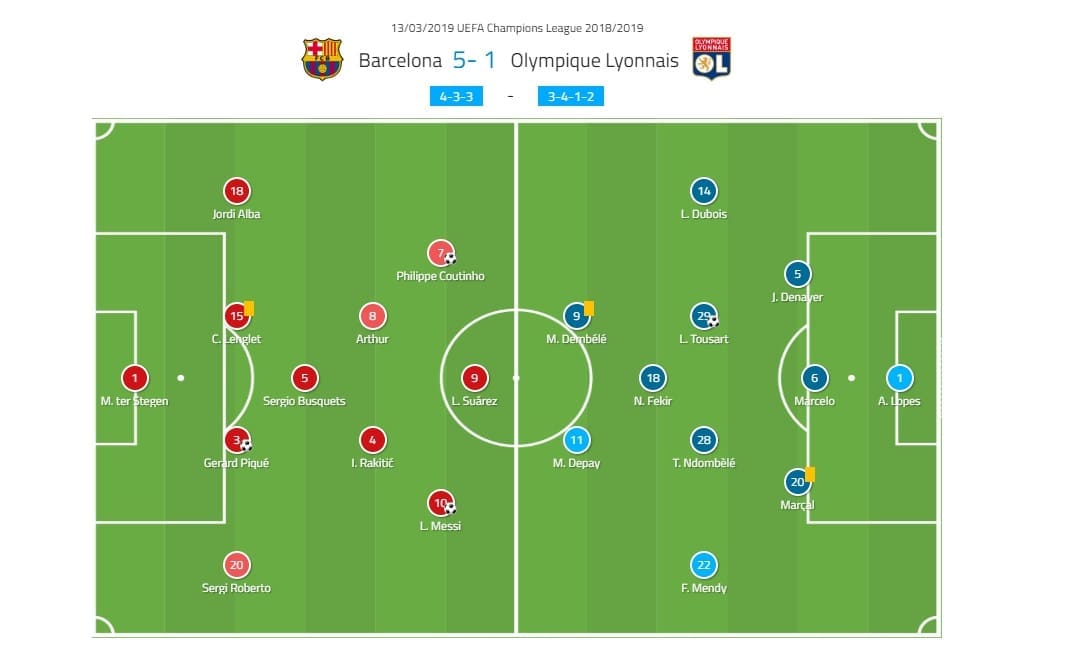
Barcelona setup
Ernesto Valverde made only two changes to the lineup he chose a couple of weeks back when these two teams faced off in France for the first leg. Back then, he did not have the luxury of including Arthur Melo in the team, as the Brazilian was injured and replaced by Sergi Roberto in midfield. But now Melo was ready and in the heart of Barcelona’s midfield.
The other difference was Ousmane Dembele starting in the front trio alongside Lionel Messi and ex-Liverpool hitman Luis Suarez. This time round though, the Frenchman had minor trouble with his muscles so Valverde decided to bench him, and not risk aggravating the potential injury even more. In his place came Philippe Coutinho who looked a lot sharper than in recent weeks.
The rest of the team was as expected with Barcelona fielding their first-choice XI as they continue their hunt of the illustrious Champions League title. The Catalans were deployed in a 4-3-3 system but made a late swap to 4-4-2 until the end of the match.
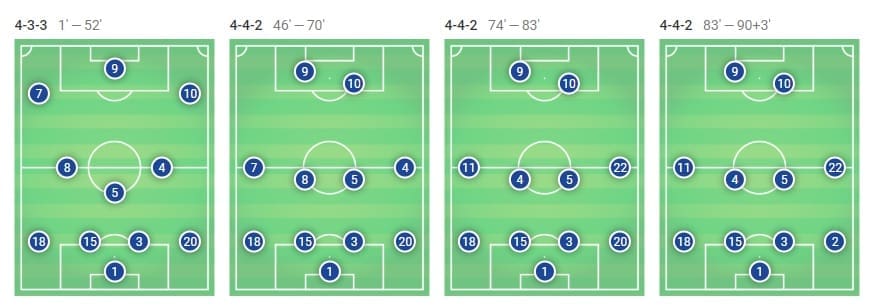
Lyon setup
Bruno Genesio did exceptionally well to survive the first encounter against the Catalan giants but now he had an even bigger task: taking them down in their own fortress where they hadn’t lost once in 29 consecutive games, racking up 26 wins and only three draws in the process.
Safe to say, it was a tall task, and one Genesio and Lyon were unfortunately not up for. Still, in an effort to somehow continue the trend of upsets in the Champions League this season, the coach of the French team made three changes to the team that faced Barcelona a couple of weeks ago in the first leg.
The first incorporation was the inclusion of an extra defender for a five-man back line consisting of the same four as last time but with Fernando Marcal as the added defensive measure. Lucas Tousart was the second change as Bertrand Traore dropped to the bench. Finally, Nabil Fekir was back since his suspension was over, and took his place in the lineup, relegating Martin Terrier to the stands in the process.
Lyon operated in a compact 3-4-1-2 system but transitioned to a 5-3-2/ 4-2-3-1 throughout the game.
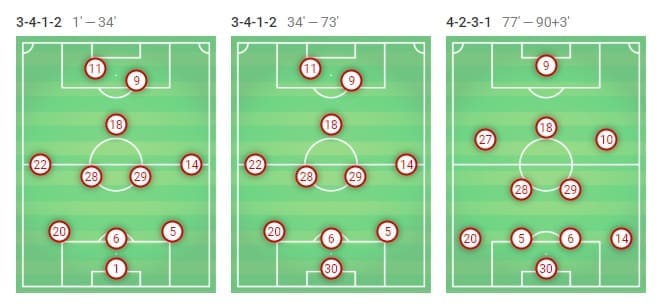
Barcelona assert dominance right at the start
With a somewhat disappointing first leg in France for Barcelona, it was all to play for in Catalunya for both sides. The home team, however, decided to leave nothing to chance as they put the pedal to the metal from the first until the very last whistle of the game.
Ernesto Valverde’s attacking game plan was clearly visible with the choice of deploying Sergi Roberto instead of Nelson Semedo. The former boasts greater attacking instinct and aptitude, whereas the latter is the more defensive option. The main reason behind this is their tendency to push forward.
While the Portuguese international needs a bigger presence in front of him in the form of a true winger that offers him link-up options, the Spaniard likes to venture to the final third by himself.
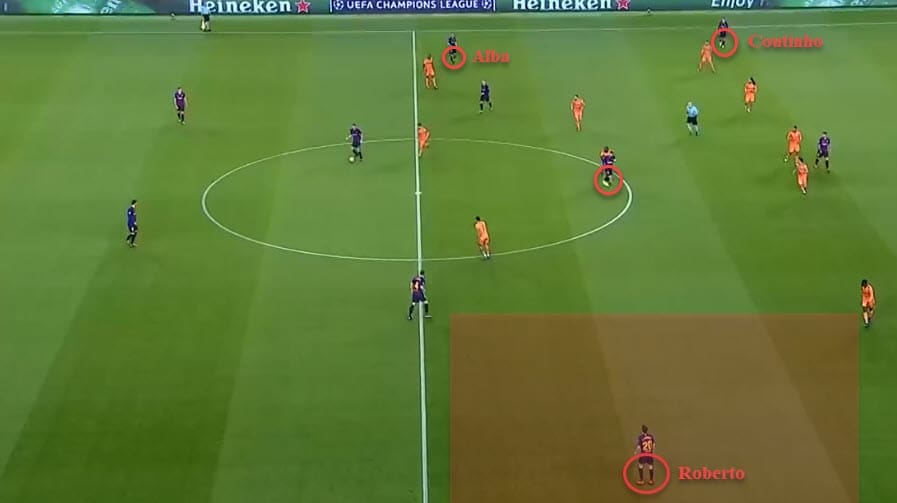
See how Roberto gets a whole flank for himself on the right side while Alba, even though he is a true full-back, has Coutinho in front. Usually this would stop Alba from overlapping and participating in the attack as much, but with Coutinho making good decisions on whether to go wide or cut inside, Alba was not hindered by the Brazilian’s presence.
Speaking of Coutinho, he had a great night as well, but that was closely connected to his communication with Arthur Melo in midfield. The young midfielder dictated play and set his compatriot on the right path, instructing him in a way.
Melo finished the game with an immense 97% passing accuracy (66/68) and 100% passes completed into the final third. The interesting thing was the fact that most of those passes were clearly focusing the left side of the pitch (33/68), the side where Coutinho operated. Seven of those were to Coutinho and 20 to Jordi Alba which is only further proof of how Arthur influenced Barcelona’s more dominant attack side.
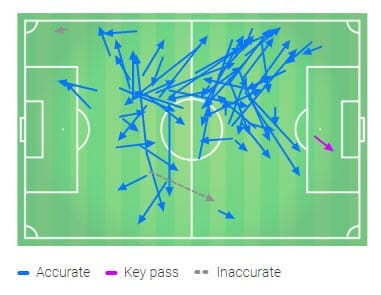
The other way Ernesto Valverde brought some spark into Barcelona’s attack was once again the instruction to Ivan Rakitić to play the role of an attacking midfielder, as well as a defensive one. The Croat had an average night at the Camp Nou but did his job well going both ways.
When there was a possibility for a break or a counter, Rakitić was the midfielder closest to the opposition’s goal, but in case Messi inevitably ventured into midfield, Rakitić was also there to cover for Roberto, who was also positioned really high up the pitch.
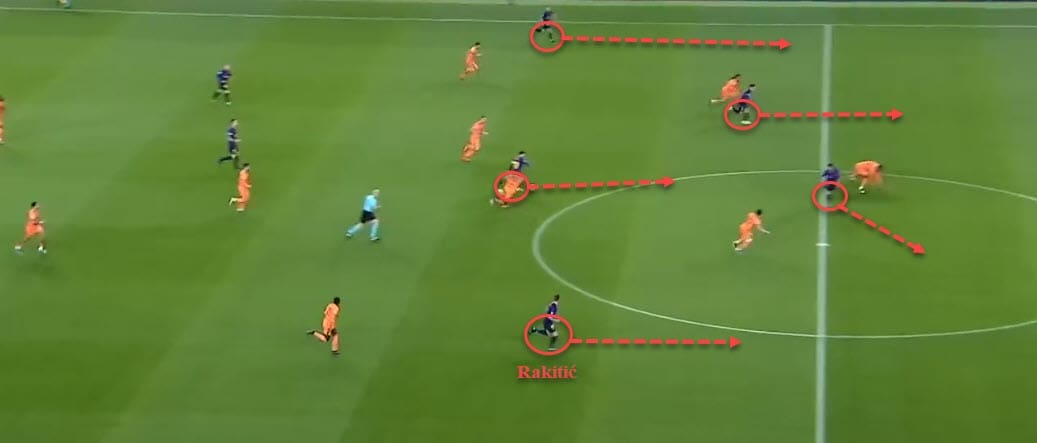
With a tight grip on the game, Barcelona dominated possession and did not let Lyon out of their own half, as their possession stats show below. The Catalans deployed an extremely high press which forced the French team to clear the ball more often than not, resulting in the loss of possession.
This worked perfectly since it deprived the opposition of any chance to attack or take hold of the ball for prolonged spells of time. The first half was therefore all Barcelona’s, but Lyon would get their five minutes under the sun come the middle of the second half.
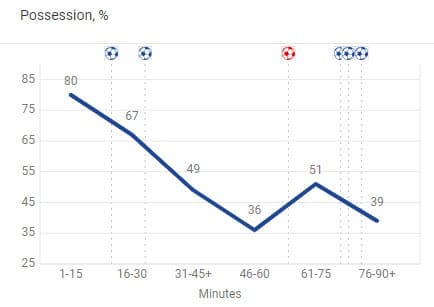
A wake-up call
Champions League nights are special for numerous reasons but if we ever needed more proof that Barcelona are clearly going all out for it this year, we have to look no further than their attacking trident against Lyon.
Lionel Messi was once again the star of the whole show, racking up two goals, two assists, two big chances but also by doing what we rarely see him do nowadays: defend. The little Argentine wizard was racing back, winning the ball both in the opposition’s half by pressing constantly, and also by making recoveries deep inside his own territory, as can be seen in the image below.
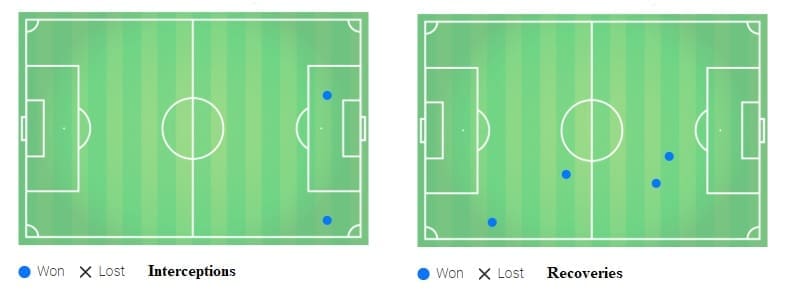
This gave Barcelona an extra man in defensive transitions and made sure they reclaimed the ball as soon as possible upon losing it. The other shining part was Luis Suarez, who, even though he did not score a goal on the night, is a true candidate for man of the match.
The Uruguayan showed glimpses of his true lethal self by participating in every attack and doing his job tirelessly for the majority of the game. His instructions were plain and simple: attract multiple markers, shield the ball, and then proceed to send it into the final third.
Sometimes, this meant he would assist others, as he did Philippe Coutinho for the second goal, and sometimes it meant that he would get to be the one profiting off the new-found free space behind Lyon’s back line.
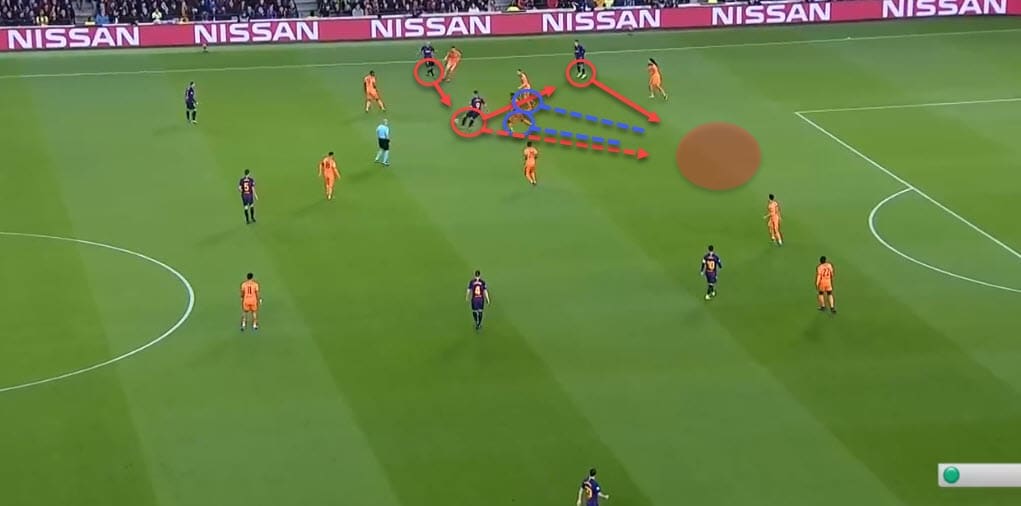
Here, Suarez drops deeper to receive the ball and pull away Lyon’s defenders, leaving their back’s exposed. A rather simple one-two with Coutinho set the Uruguayan free to attack the free space.
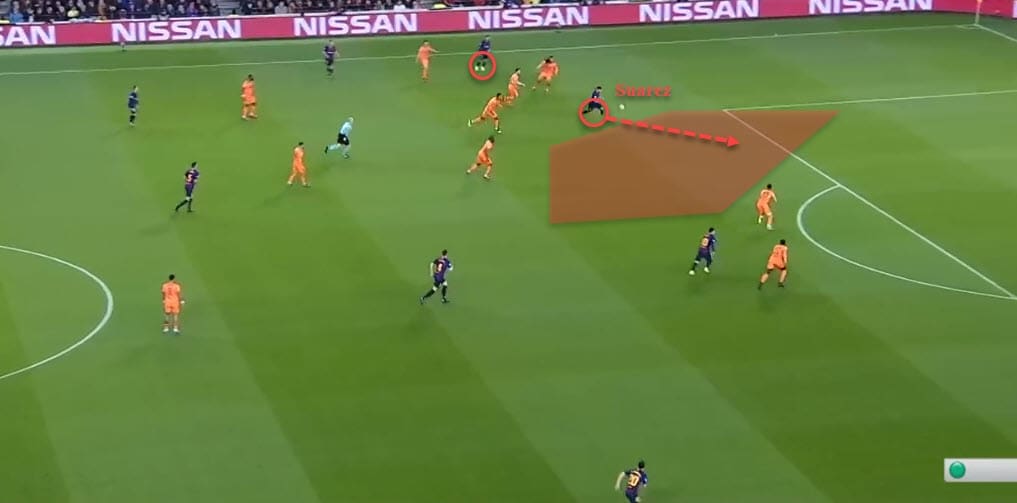
This occurrence was common during the game, and Suarez exploited it to the fullest of his abilities, especially in the first half. Another clear example can be seen below as he creates space for Arthur Melo by dragging the defender to the side.
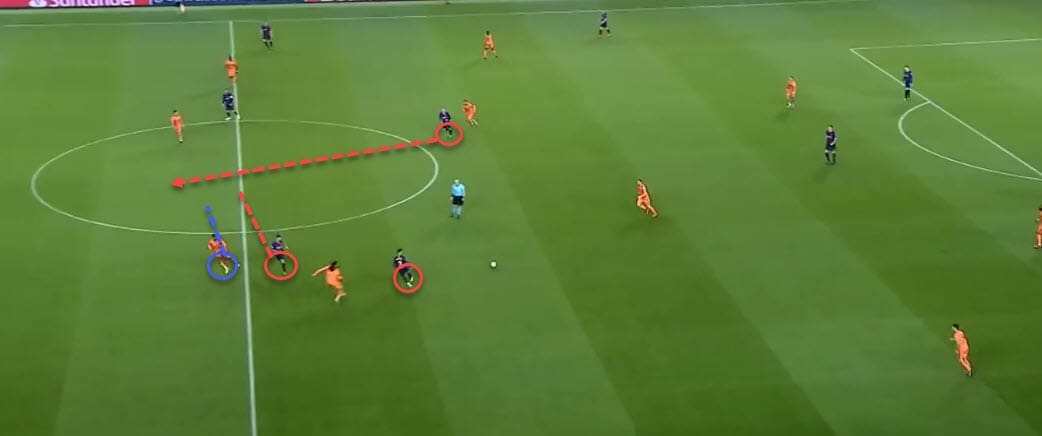
Philippe Coutinho also seemed to have found his groove, at least for the night and the time being. The Brazilian came forward after the game and admitted he is going through a rough patch but on Wednesday night, he seemed to be (almost) back to his magical best.
He had a similar task to Luis Suarez but he operated in somewhat different areas of the pitch. In most cases, Coutinho found himself in the left half-space, which allowed Jordi Alba to overlap and also manipulate the movement of his markers.
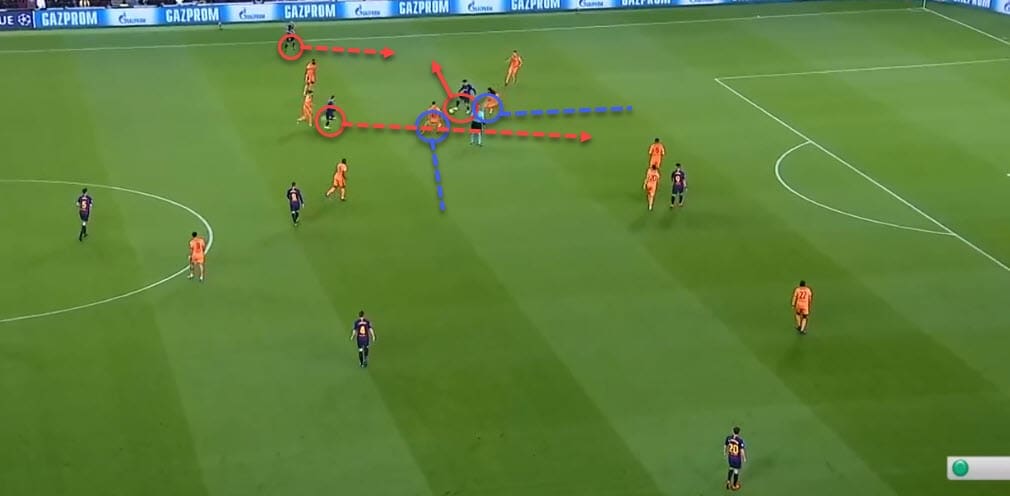
Here, Coutinho is quickly surrounded by multiple opposition players. But Barcelona’s ability to invite the press and then disperse it quickly meant that they would easily get out of those Lyon’s traps.
Denayer follows the Brazilian, leaving his spot empty once more, and a combination of Coutinho, Alba and Messi gives Barcelona a clear chance in front of goal. It looks simple, but only because it was orchestrated extremely well.
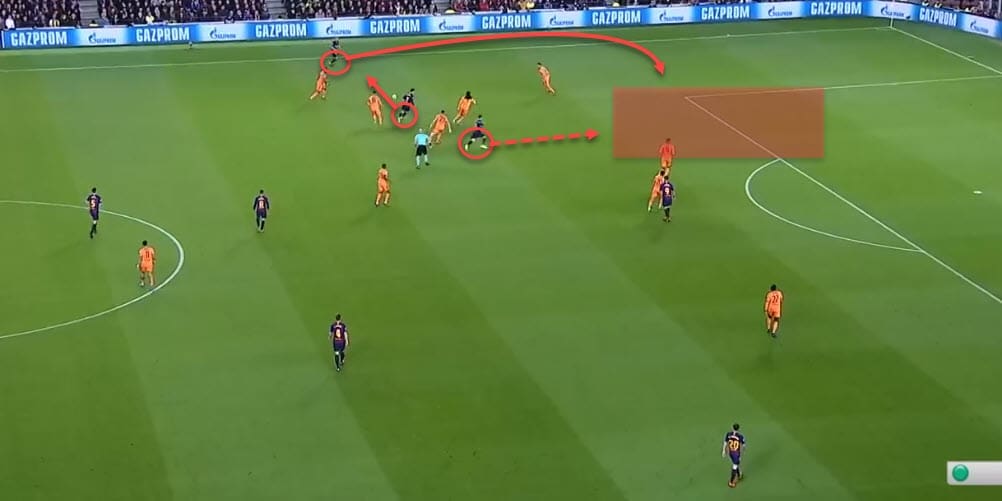
The final nail in the coffin was Ousmane Dembele, who took up Coutinho’s spot on the left in the latter stages of the game and provided the team with a different attacking outlet to what the Brazilian was offering.
The Frenchman stayed wide and stretched Lyon’s backline. This gave more space to Messi to operate in the middle, and either put himself in promising situations or give his teammates that same luxury.
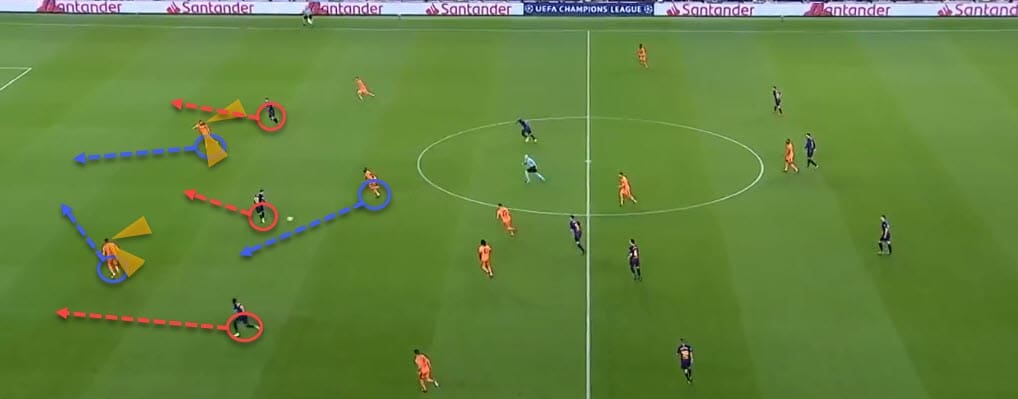
Since the 2-1 scoreline at that time was dangerous for Barcelona, Lyon finally started coming out of their defensive shape. This meant more space for the hosts in the first place. Dembele’s pace and unpredictability caused havoc for the French team.
In the image above, Lyon have to stay a bit wider due to Dembele’s positioning but that leaves Lionel Messi all alone in the middle of the park. At this point, the defenders have to make a choice: stick with Dembele and risk letting Messi go free, or follow Messi and leave Dembele free.
In general, both decisions are bad as it was a win-win situation for the Catalans. Lyon opt for the latter option but still end up punished as Messi gets rid of both his markers easily and scores with his weak foot.
Lyon show signs of life
Even though they were the clear underdogs for the vast majority of the game at the Camp Nou, Lyon were one step, or rather one goal, away from setting fire beneath Barcelona’s feet. At 2-0 the game was firmly in the Catalans’ hands but as soon as the French team found a way to get past Marc-Andre ter Stegen, for the first and the only time on the night, the tension rose incredibly.
The goal itself (and the lost control) was a direct result of a couple of aspects. Barcelona were not able to sustain their high press throughout the whole 90 minutes, and their defending was sloppy in the box.
In the second half, Barcelona would often transition to a mid-defensive block with two banks of four, leaving Messi and Suarez as the only players up front. The difference between the high press and 4-4-2 defensive block can be seen in the images below.

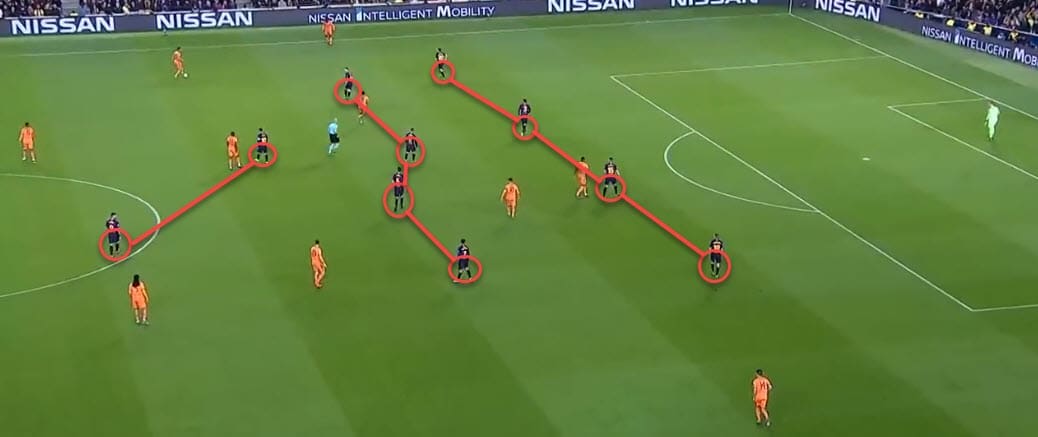
On paper, Lyon attacked in a 3-4-1-2 system which looked more like a clear 3-4-3 now that Nabil Fekir was back in the squad, as he is at the core of their attacking movements. Similar to Barcelona’s attack style, the French team also preferred to attack down their left (42%) but instead of a slower build-up, they opted for fast transitions to catch the Catalans off guard.
All three of their counter-attacks ended with a shot on goal, which only shows their efficiency in transitioning between defence and attack. Their lack of greater finishing touches, however, cost them a better chance of progressing to the quarter-finals.
Below we can see how they utilised Mendy’s ability to overlap and exploit free space behind the defence. This was done often with long balls or with quick switches of play when the French team were on the attack.
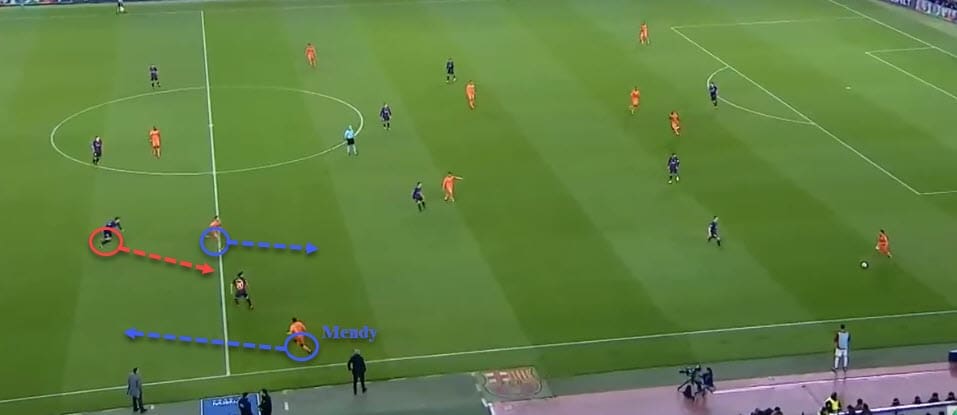
They counted on creating numerical superiorities to get past Barcelona’s blocks. But since Messi tracked back a lot more than usual, as stated before, Lyon encountered tougher resistance than they maybe expected, and thus did not have as many chances as they had hoped for.
Once Arturo Vidal and Ousmane Dembele were introduced, and Lyon were forced to come out of their shell to get that second goal, their defence was left much more exposed, which resulted in a rather dominant scoreline for Barcelona.
Conclusion
At one point in the second half, just as Lyon got their goal to get back into the game, the ground below Barcelona started trembling just a little bit. But alas, Lionel Messi was there to answer Cristiano Ronaldo’s call from the night before in Turin. The little Argentine delivered once again to give the Catalans an unfair advantage on the pitch.
Although the French team did well to keep a clean sheet at their home ground, the tables turned pretty quickly once the venue was changed to the Camp Nou. The result itself might be a bit flattering but it’s difficult to argue that Barcelona did not deserve it with a total xG value of 5.7 (+1 penalty) over both legs as opposed to Lyon’s xG of 1.0.
The stage is once again set for football’s best to collide as we eagerly await the quarter-final draw this Friday afternoon.
If you love tactical analysis, then you’ll love the digital magazines from totalfootballanalysis.com – a guaranteed 100+ pages of pure tactical analysis covering topics from the Premier League, Serie A, La Liga, Bundesliga and many, many more. Buy your copy of the March issue for just ₤4.99 here, or even better sign up for a ₤50 annual membership (12 monthly issues plus the annual review) right here.

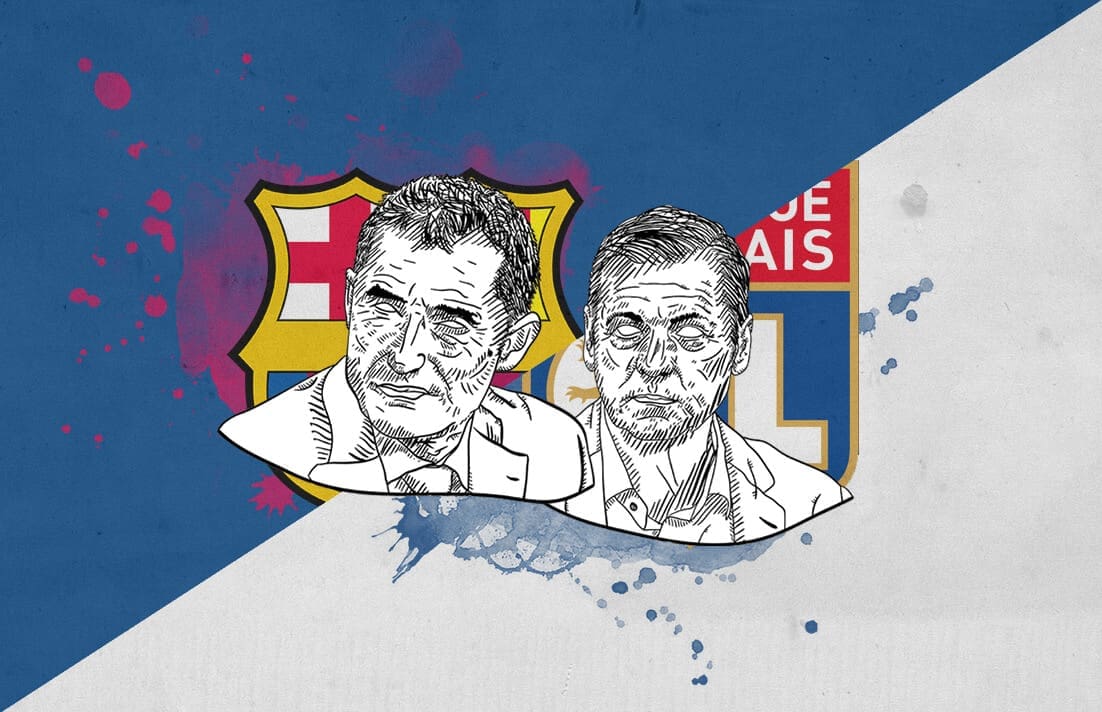




Comments